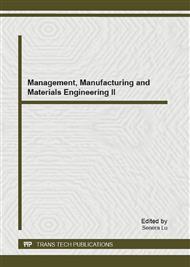p.64
p.69
p.74
p.79
p.84
p.89
p.94
p.99
p.105
Preparation, Characterization of Cu Nanowires and their Tribological Property in Liquid Paraffin
Abstract:
In order to synthesize morphology and structure-controlled nano-copper, chemical reduction synthesis method was used coalescing microwave-assisted and modification. Cu nanowires with diameters of 20 to 25nm and lengths of 1.2 to 2.1μm were yielded by reduction of copper acetate tetrahydrate of (1, 2)-propanediol system using ascorbic acid as a reductant, polyethylene sorbitan monooleate (Tween 80) as a modifier and by microwave-assisted heating. The microstructure of these nanowires has been characterized by XRD and TEM. The XRD patterns indicate that the lattice parameters of these Cu nanowires are enlarged about 1.162% while the lattice parameters of Cu nanospheres are reduced about 1.024%. The growth mechanism of Cu nanowires is also suspected. The anti--wear and reducing friction performance of liquid paraffin with either Cu nanowires or Cu nanospheres has been measured by ball--on--disk UMT--II tribometer. It is found that the tribological performance of liquid paraffin with nano-Cu is improved, and the enhancement of improvement with Cu nanowires is better than with Cu nanospheres.
Info:
Periodical:
Pages:
84-88
Citation:
Online since:
December 2012
Authors:
Price:
Сopyright:
© 2013 Trans Tech Publications Ltd. All Rights Reserved
Share:
Citation:


